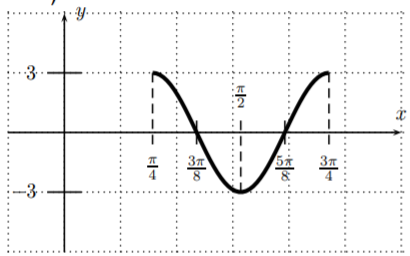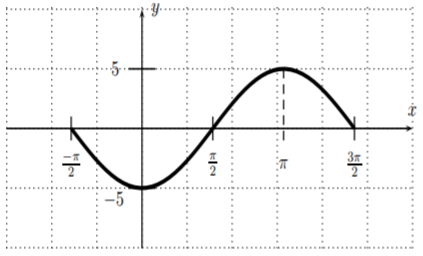27.4: Review of trigonometric functions
- Page ID
- 68485
\( \newcommand{\vecs}[1]{\overset { \scriptstyle \rightharpoonup} {\mathbf{#1}} } \)
\( \newcommand{\vecd}[1]{\overset{-\!-\!\rightharpoonup}{\vphantom{a}\smash {#1}}} \)
\( \newcommand{\dsum}{\displaystyle\sum\limits} \)
\( \newcommand{\dint}{\displaystyle\int\limits} \)
\( \newcommand{\dlim}{\displaystyle\lim\limits} \)
\( \newcommand{\id}{\mathrm{id}}\) \( \newcommand{\Span}{\mathrm{span}}\)
( \newcommand{\kernel}{\mathrm{null}\,}\) \( \newcommand{\range}{\mathrm{range}\,}\)
\( \newcommand{\RealPart}{\mathrm{Re}}\) \( \newcommand{\ImaginaryPart}{\mathrm{Im}}\)
\( \newcommand{\Argument}{\mathrm{Arg}}\) \( \newcommand{\norm}[1]{\| #1 \|}\)
\( \newcommand{\inner}[2]{\langle #1, #2 \rangle}\)
\( \newcommand{\Span}{\mathrm{span}}\)
\( \newcommand{\id}{\mathrm{id}}\)
\( \newcommand{\Span}{\mathrm{span}}\)
\( \newcommand{\kernel}{\mathrm{null}\,}\)
\( \newcommand{\range}{\mathrm{range}\,}\)
\( \newcommand{\RealPart}{\mathrm{Re}}\)
\( \newcommand{\ImaginaryPart}{\mathrm{Im}}\)
\( \newcommand{\Argument}{\mathrm{Arg}}\)
\( \newcommand{\norm}[1]{\| #1 \|}\)
\( \newcommand{\inner}[2]{\langle #1, #2 \rangle}\)
\( \newcommand{\Span}{\mathrm{span}}\) \( \newcommand{\AA}{\unicode[.8,0]{x212B}}\)
\( \newcommand{\vectorA}[1]{\vec{#1}} % arrow\)
\( \newcommand{\vectorAt}[1]{\vec{\text{#1}}} % arrow\)
\( \newcommand{\vectorB}[1]{\overset { \scriptstyle \rightharpoonup} {\mathbf{#1}} } \)
\( \newcommand{\vectorC}[1]{\textbf{#1}} \)
\( \newcommand{\vectorD}[1]{\overrightarrow{#1}} \)
\( \newcommand{\vectorDt}[1]{\overrightarrow{\text{#1}}} \)
\( \newcommand{\vectE}[1]{\overset{-\!-\!\rightharpoonup}{\vphantom{a}\smash{\mathbf {#1}}}} \)
\( \newcommand{\vecs}[1]{\overset { \scriptstyle \rightharpoonup} {\mathbf{#1}} } \)
\( \newcommand{\vecd}[1]{\overset{-\!-\!\rightharpoonup}{\vphantom{a}\smash {#1}}} \)
\(\newcommand{\avec}{\mathbf a}\) \(\newcommand{\bvec}{\mathbf b}\) \(\newcommand{\cvec}{\mathbf c}\) \(\newcommand{\dvec}{\mathbf d}\) \(\newcommand{\dtil}{\widetilde{\mathbf d}}\) \(\newcommand{\evec}{\mathbf e}\) \(\newcommand{\fvec}{\mathbf f}\) \(\newcommand{\nvec}{\mathbf n}\) \(\newcommand{\pvec}{\mathbf p}\) \(\newcommand{\qvec}{\mathbf q}\) \(\newcommand{\svec}{\mathbf s}\) \(\newcommand{\tvec}{\mathbf t}\) \(\newcommand{\uvec}{\mathbf u}\) \(\newcommand{\vvec}{\mathbf v}\) \(\newcommand{\wvec}{\mathbf w}\) \(\newcommand{\xvec}{\mathbf x}\) \(\newcommand{\yvec}{\mathbf y}\) \(\newcommand{\zvec}{\mathbf z}\) \(\newcommand{\rvec}{\mathbf r}\) \(\newcommand{\mvec}{\mathbf m}\) \(\newcommand{\zerovec}{\mathbf 0}\) \(\newcommand{\onevec}{\mathbf 1}\) \(\newcommand{\real}{\mathbb R}\) \(\newcommand{\twovec}[2]{\left[\begin{array}{r}#1 \\ #2 \end{array}\right]}\) \(\newcommand{\ctwovec}[2]{\left[\begin{array}{c}#1 \\ #2 \end{array}\right]}\) \(\newcommand{\threevec}[3]{\left[\begin{array}{r}#1 \\ #2 \\ #3 \end{array}\right]}\) \(\newcommand{\cthreevec}[3]{\left[\begin{array}{c}#1 \\ #2 \\ #3 \end{array}\right]}\) \(\newcommand{\fourvec}[4]{\left[\begin{array}{r}#1 \\ #2 \\ #3 \\ #4 \end{array}\right]}\) \(\newcommand{\cfourvec}[4]{\left[\begin{array}{c}#1 \\ #2 \\ #3 \\ #4 \end{array}\right]}\) \(\newcommand{\fivevec}[5]{\left[\begin{array}{r}#1 \\ #2 \\ #3 \\ #4 \\ #5 \\ \end{array}\right]}\) \(\newcommand{\cfivevec}[5]{\left[\begin{array}{c}#1 \\ #2 \\ #3 \\ #4 \\ #5 \\ \end{array}\right]}\) \(\newcommand{\mattwo}[4]{\left[\begin{array}{rr}#1 \amp #2 \\ #3 \amp #4 \\ \end{array}\right]}\) \(\newcommand{\laspan}[1]{\text{Span}\{#1\}}\) \(\newcommand{\bcal}{\cal B}\) \(\newcommand{\ccal}{\cal C}\) \(\newcommand{\scal}{\cal S}\) \(\newcommand{\wcal}{\cal W}\) \(\newcommand{\ecal}{\cal E}\) \(\newcommand{\coords}[2]{\left\{#1\right\}_{#2}}\) \(\newcommand{\gray}[1]{\color{gray}{#1}}\) \(\newcommand{\lgray}[1]{\color{lightgray}{#1}}\) \(\newcommand{\rank}{\operatorname{rank}}\) \(\newcommand{\row}{\text{Row}}\) \(\newcommand{\col}{\text{Col}}\) \(\renewcommand{\row}{\text{Row}}\) \(\newcommand{\nul}{\text{Nul}}\) \(\newcommand{\var}{\text{Var}}\) \(\newcommand{\corr}{\text{corr}}\) \(\newcommand{\len}[1]{\left|#1\right|}\) \(\newcommand{\bbar}{\overline{\bvec}}\) \(\newcommand{\bhat}{\widehat{\bvec}}\) \(\newcommand{\bperp}{\bvec^\perp}\) \(\newcommand{\xhat}{\widehat{\xvec}}\) \(\newcommand{\vhat}{\widehat{\vvec}}\) \(\newcommand{\uhat}{\widehat{\uvec}}\) \(\newcommand{\what}{\widehat{\wvec}}\) \(\newcommand{\Sighat}{\widehat{\Sigma}}\) \(\newcommand{\lt}{<}\) \(\newcommand{\gt}{>}\) \(\newcommand{\amp}{&}\) \(\definecolor{fillinmathshade}{gray}{0.9}\)Fill in all the trigonometric function values in the table below.
\[\begin{array}{c||c|c|c|c|c}
& 0 & \dfrac{\pi}{6} & \dfrac{\pi}{4} & \dfrac{\pi}{3} & \dfrac{\pi}{2} \\
\hline \hline \sin (x) & & & & & \\
\hline \cos (x) & & & & & \\
\hline \tan (x) & & & & &
\end{array} \nonumber \]
- Answer
-
\(\begin{array}{c||c|c|c|c|c}
x & 0=0^{\circ} & \dfrac{\pi}{6}=30^{\circ} & \dfrac{\pi}{4}=45^{\circ} & \dfrac{\pi}{3}=60^{\circ} & \dfrac{\pi}{2}=90^{\circ} \\
\hline \hline \sin (x) & 0 & \dfrac{1}{2} & \dfrac{\sqrt{2}}{2} & \dfrac{\sqrt{3}}{2} & 1 \\
\hline \cos (x) & 1 & \dfrac{\sqrt{3}}{2} & \dfrac{\sqrt{2}}{2} & \dfrac{1}{2} & 0 \\
\hline \tan (x) & 0 & \dfrac{\sqrt{3}}{3} & 1 & \sqrt{3} & \text { undef. }
\end{array}\)
Find the exact values of
- \(\cos\left(-\dfrac{\pi}{6}\right)\)
- \(\sin\left(-\dfrac{\pi}{4}\right)\)
- \(\tan\left(-\dfrac{\pi}{3}\right)\)
- Answer
-
- \(\dfrac{\sqrt{3}}{2}\)
- \(\dfrac{-\sqrt{2}}{2}\)
- \(-\sqrt{3}\)
Find the exact value of the trigonometric function.
- \(\sin\left(\dfrac{5\pi}{4}\right)\)
- \(\cos\left(\dfrac{11\pi}{6}\right)\)
[Hint: Use the special \(45^\circ-45^\circ-90^\circ\) or \(30^\circ-60^\circ-90^\circ\) triangles to find the solution.]
- Answer
-
- \(\dfrac{-\sqrt{2}}{2}\)
- \(\dfrac{\sqrt{3}}{2}\)
Find the amplitude, period, and the phase shift of the given function. Draw the graph over a one-period interval. Label all maxima, minima and intercepts.
- \(y=3 \cos\left(4 x-\pi\right)\)
- \(y=-5\sin\left(x+\dfrac{\pi}{2}\right)\)
- Answer
-
- amplitude \(3\), period \(\dfrac{\pi}{2}\), phase-shift \(\dfrac{\pi}{4}\)

- amplitude \(5\), period \(2\pi \), phase-shift \(\dfrac{-\pi}{2}\)

- amplitude \(3\), period \(\dfrac{\pi}{2}\), phase-shift \(\dfrac{\pi}{4}\)
Find the exact trigonometric function value.
- \(\cos\left(\dfrac{\pi}{12}\right)\) [Hint: Use the addition and subtraction of angles formulas.]
- \(\cos\left(\dfrac{3\pi}{8}\right)\) [Hint: Use the half-angles formulas.]
- Answer
-
- \(\dfrac{\sqrt{2}+\sqrt{6}}{4}\)
- \(\dfrac{\sqrt{2-\sqrt{2}}}{2}\)
Let \(\sin(\alpha)=-\dfrac{4}{5}\) and let \(\alpha\) be in quadrant III. Find \(\sin(2\alpha)\), \(\cos(2\alpha)\), and \(\tan(2\alpha)\).
- Answer
-
\(\sin (2 \alpha)=\dfrac{24}{25}, \cos (2 \alpha)=\dfrac{-7}{25}, \tan (2 \alpha)=\dfrac{-24}{7}\)
Find the exact value of:
- \(\sin^{-1}\left(-\dfrac{1}{2}\right)\)
- \(\cos^{-1}\left(-\dfrac{\sqrt{3}}{2}\right)\)
- \(\tan^{-1}\left(-\dfrac{\sqrt{3}}{3}\right)\)
- Answer
-
- \(\dfrac{-\pi}{6}\)
- \(\dfrac{5 \pi}{6}\)
- \(\dfrac{-\pi}{6}\)
Solve for \(x\): \(2\sin(x)+\sqrt{3}=0\)
- Answer
-
\(x=(-1)^{n+1} \dfrac{\pi}{3}+n \pi\), where \(n=0, \pm 1, \ldots \)
Solve for \(x\): \(\tan^2(x)-1=0\)
- Answer
-
\(x=\pm \dfrac{\pi}{4}+n \pi \) where \(n=0, \pm 1, \ldots \)
Solve for \(x\).
- \(2\cos^2(x)-1=0\)
- \(2\sin^2(x)+15\sin(x)+7=0\)
- Answer
-
- \(x=\pm \dfrac{\pi}{4}+2 n \pi\) or \(x=\pm \dfrac{3 \pi}{4}+2 n \pi\) where \(n=0, \pm 1, \ldots\)
- \((-1)^{n+1} \dfrac{\pi}{6}+n \pi\) where \(n=0, \pm 1, \ldots\)


